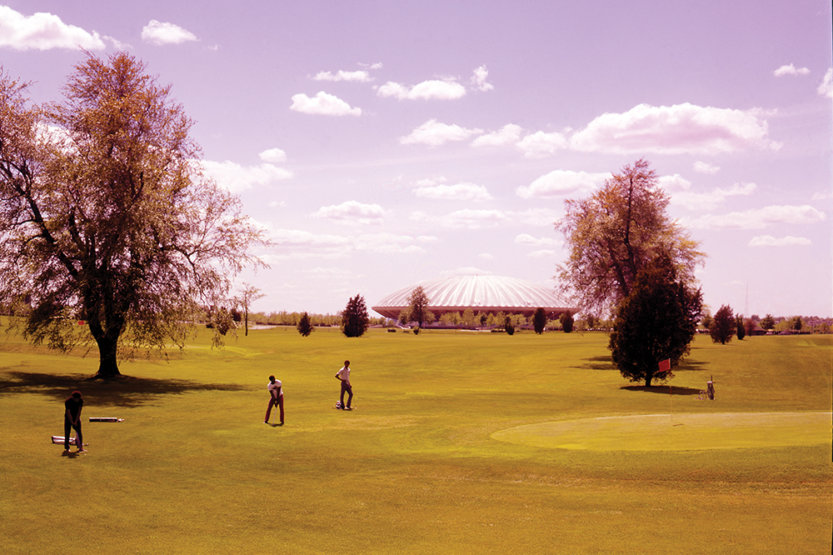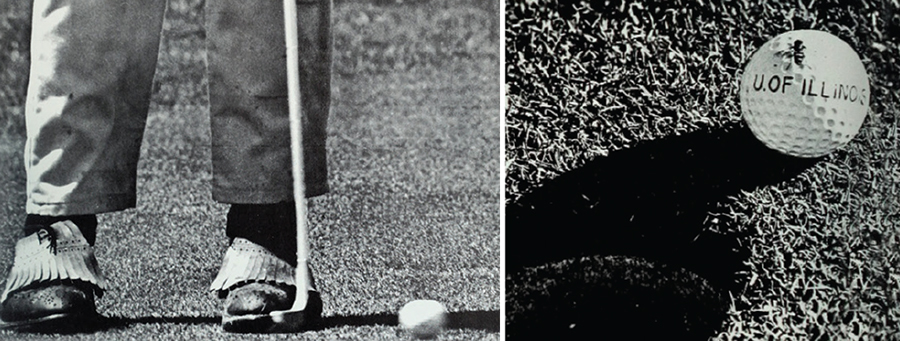Memory Lane: The Rinky Dink
 “It was a fun little course,” says Doug Houston of the nine-hole course located south of Kirby Street and east of Fourth Street.
Affectionately known as the Rinky Dink, it was free on weekends for students taking a golf class. (Image Courtesy of UI Archives)
“It was a fun little course,” says Doug Houston of the nine-hole course located south of Kirby Street and east of Fourth Street.
Affectionately known as the Rinky Dink, it was free on weekends for students taking a golf class. (Image Courtesy of UI Archives) Joe Rank, ’69 MEDIA, MS ’73 MEDIA, happily spent many days during spring semester of his sophomore year playing golf. A rank beginner (pun intended), the advertising major from Urbana hit his share of errant slices and hooks. But he was not playing hooky: golf was an elective. Back then, every student had to take four semesters of physical education. Rank carried his clubs to class: The short, ragged, but cherished on-campus course, located south of Kirby Street and east of Fourth Street, was a tee shot from Assembly Hall (now the State Farm Center).
The nine-hole course was affectionately known as the Rinky Dink. Students also dubbed it the Suicide Nine. That name of dread fit because the course adjoined Roselawn Cemetery, where golfers hunting down off-target shots carefully maneuvered around weathered headstones. Equally dreadful, balls often sailed off the course and hit the cars of unsuspecting drivers.
“It was a fun little course. It had extremely narrow fairways with tees practically side by side with greens,” says Doug Houston, ’70 FAA. Back then, the course—like the University—was more rural, less developed, practically quaint. Near the course was a field of cows. “If you were playing and heard mooing, you knew rain was coming, and it was time to head inside,” Richard Wooley, ’61 AHS, EDM ’66, fondly recalls.
The course was open to students not in a golf class as well as faculty and staff. Richard Johnson, PHD ’65, hacked away with Harold Decker, former director of the University choirs. “The course is where I learned to play. Ha! Forty years later, not much improvement,” wrote Johnson on a Facebook page dedicated to Champaign-Urbana history.
Golf can be an elitist, exclusive enterprise, especially back in the day, and generations ago, college was decidedly more regimented. But everything about the course was delightfully casual and laid-back. The starter’s shack was indeed a flimsy shack. On some days, the course was not monitored, and a golfer could just walk on. It was convenient—just blocks from residence halls. It was accessible—short wait times. And it was oh-so-cheap, free even on weekends for students taking golf class, and otherwise $1 or even 50 cents in the 1950s.
You got what you paid for. The course was pancake-flat. There was no water. The bunkers were postage stamp-size. And the layout was uninspiring—one oblong hole after another, side by side. “It was not scenic. It was good for what it was used for,” says Tom Porter, who later became the University’s wrestling coach, an assistant football coach and an administrator. As with other students, the availability of the course did not necessarily lead to excellence on the links. “I golf like a wrestler,” he says with a chuckle.
While fulfilling his phys ed requirement, Rank did extra credits, so to speak, golfing outside class. “I probably spent more time out there than I should have. I had my worst GPA that semester,” he recalls. He did earn an A in golf. Grades were based on improvement and the number of completed rounds.

The course was taught—well, moderated—by Howie Braun, a longtime assistant basketball coach. “I don’t want to speak ill of him, but there wasn’t a whole lot of instruction,” Rank says.
The course was open to the public. It drew young moms looking to get out of the house and teenagers with no more than spare change in their pockets. Michael Felty, ’75 LAS, often played as a high school student in Urbana. “I had a cloth bag with four clubs that I carried when I biked over there,” he reminisces on the Champaign Facebook page.
The holes were so short that the course was sometimes erroneously called a Par 3. But its playability was part of its charm. “I brought only three clubs—a 3-wood, a 7-iron and a putter,” says Rank.
The course was filled with cars on football Saturdays, though the University roped off the greens. That use of the precious open space foretold the inevitable. In 1983, the course was demolished for the track stadium, and then the Atkins Tennis Center, the baseball field and the Bielfeldt Athletics Administration Building.
It’s inconceivable today that such a rinky-dink course would be offered to students. “Times have changed. Amenities have changed so much,” says Rank, who served in the Navy before joining the UI Alumni Alliance as vice president. “It was good to get out on a nice day. It was a nice respite from class.”

